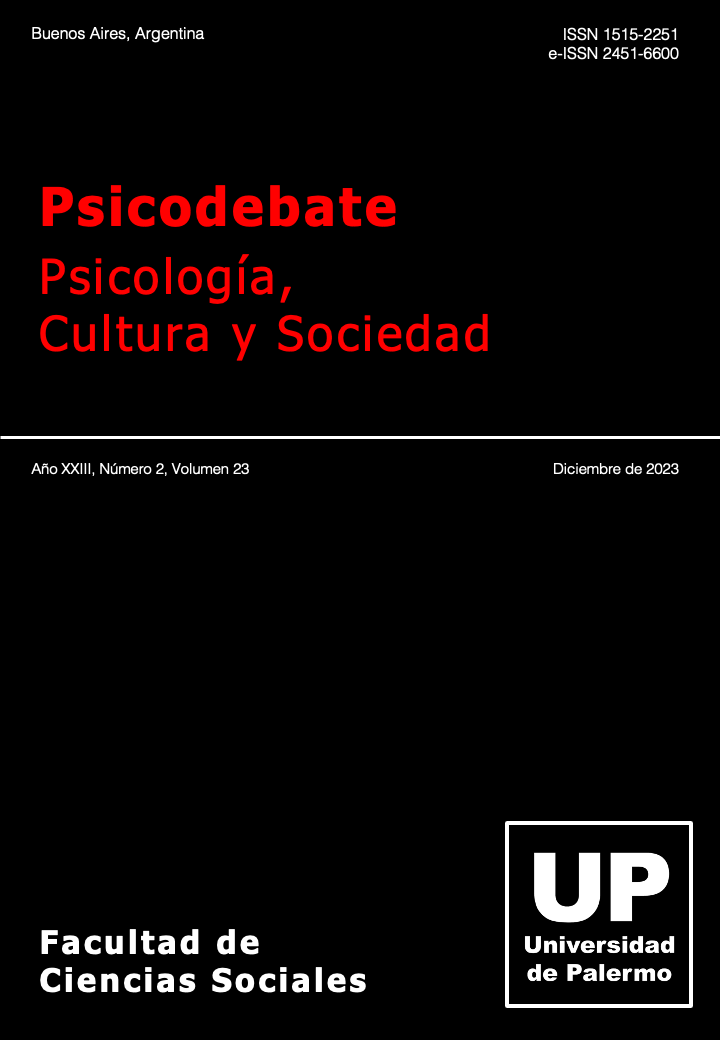Adaptation of the Posttraumatic Growth Inventory in people with HIV from Buenos Aires, Argentina
Abstract
Posttraumatic growth (PTG) involves positive psychological changes resulting from coping with highly challenging circumstances. The Posttraumatic Growth Inventory (PTGI) is the most widespread instrument for its measurement. A substantial proportion of people with HIV experience some degree of PTG as a result of their diagnosis, which is associated with better mental and physical health. The objective was to adapt the PTGI for its use in people with HIV in the Metropolitan Area of Buenos Aires (MABA), Argentina. A preliminary version, linguistically and conceptually equivalent to the original one, was administered to a sample of 100 adults living with HIV from the MABA. According to the confirmatory factor analysis, the original model of five dimensions showed a better fit. Consistently with international evidence, female participants exhibited significantly higher PTG scores, which can be interpreted as external evidence of validity. Reliability and internal consistency of the scale and its dimensions were verified through the ordinal alpha and omega coefficients, obtaining acceptable and excellent values. This version of the PTGI demonstrated acceptable psychometric properties and cultural adequacy for its use in people with HIV from the MABA.
Downloads
References
Amiri, H., Rezapour, M., Nekoei-Moghadam, M., & Nakhaee, N. (2020). Translation and adaptation of the Posttraumatic Growth Inventory-Short Form into Persian. The Open Psychology Journal, 13, 326-332. https://doi.org/10.2174/1874350102013010326
Arias, P. R., García, F. E., & Valdivieso, I. P. (2017). Propiedades psicométricas del Inventario de Crecimiento Postraumático en población ecuatoriana. Evaluar, 17(2), 67-80. https://doi.org/10.35670/1667-4545.v17.n2.18722
Aslam, N., & Kamal, A. (2019). Assessing positive changes among flood affected individuals: Translation and validation of Post-Traumatic Growth Inventory - Short Form (PTGI-SF). Pakistan Journal of Medical Research, 58(2), 59-65.
Browne, M. W., & Cudeck, R. (1992). Alternative ways of assessing model fit. Sociological Methods and Research, 21(2), 230-258. https://doi.org/10.1177/0049124192021002005
Cárdenas Castro, M., Barrientos Delgado, J., Ricci Alvarado, E., & Páez Rovira, D. (2015). Spanish adaptation and validation of the Posttraumatic Growth Inventory–Short Form. Violence and Victims, 30(5), 756-769. https://doi.org/10.1891/0886-6708.VV-D-13-00165
Dubuy, Y., Sébille, V., Bourdon, M, Hardouin, J. B., & Blanchin, M. (2022). Posttraumatic growth inventory: challenges with its validation among French cancer patients. BMC Medical Research Methodology, 22(1), 246. https://doi.org/10.1186/s12874-022-01722-6
Dunn, T. J., Baguley, T., & Brunsden, V. (2014). From alpha to omega: a practical solution to the pervasive problem of internal consistency estimation. British Journal of Psychology, 105(3), 399-412. https://doi.org/10.1111/bjop.12046
Escurra, L. M. (1988). Cuantificación de la validez de contenido por criterio de jueces. Revista de Psicología de la Pontificia Universidad Católica del Perú, 6(1-2), 103-111. https://doi.org/10.18800/psico.198801-02.008
Esparza-Baigorri, T., Leibovich de Figueroa, N., & Martínez-Terrer, T. (2016). Propiedades psicométricas del Inventario de Crecimiento Postraumático en pacientes oncológicos en población argentina. Ansiedad y Estrés, 22, 97-103. https://doi.org/10.1016/j.anyes.2016.06.002
Finkelstein-Fox, L., Park, C. L., & Kalichman, S. C. (2020): Health benefits of positive reappraisal coping among people living with HIV/AIDS: A systematic review, Health Psychology Review, 14(3), 394-426. https://doi.org/10.1080/17437199.2019.1641424.
Garcia da Silva, T. L., Guimarães Ramos, V., Candia Donat, J., Rainho de Oliveira, F., Gauer, G., & Haag Kristensen, C. (2018). Psychometric properties of the Posttraumatic Growth Inventory in a sample of Brazilian university students. Trends in Psychiatry and Psychotherapy, 40(4), 292-299. https://doi.org/10.1590/2237-6089-2017-0050
García, F. E., Solar, F., & Melipillán, R. (2013). Propiedades psicométricas del Inventario de Crecimiento Postraumático en población chilena afectada por un desastre natural. Revista Mexicana de Psicología, 30(2), 145-153.
Garrido-Hernansaiz, H., & Alonso-Tapia, J. (2020). Predictors of anxiety and depression among newly diagnosed people living with HIV: A longitudinal study. Scandinavian Journal of Psychology, 61(5), 616-624. https://doi.org/10.1111/sjop.12621.
Garrido-Hernansaiz, H., Murphy, P. J., & Alonso-Tapia, J. (2017). Predictors of resilience and posttraumatic growth among people living with HIV: A longitudinal study. AIDS and Behavior, 21(11), 3260-3270. https://doi.org/10.1007/s10461-017-1870-y
Garrido-Hernansaiz, H., Rodríguez-Rey, R., Collazo-Castiñeira, P., & Collado, S. (2022). The Posttraumatic Growth Inventory-Short Form (PTGI-SF): A psychometric study of the Spanish population during the COVID-19 pandemic. Current Psychology, 1-10. https://doi.org/10.1007/s12144-021-02645-z
George, D. & Mallery, P. (2003). SPSS for Windows step by step: A simple guide and reference. 11.0 update (4th Ed.). Allyn & Bacon.
George, D. & Mallery, P. (2011). SPSS for Windows step by step: A simple guide and reference. 18.0 update (1st Ed.). Pearson.
Gómez-Acosta, A., Ramos-Vera, C., & Sierra Barón, W. (2022). Validation of an ultra-short version of the Posttraumatic Growth Inventory in Colombian adults exposed to COVID-19. Death Studies, 47(4), 490-498. https://doi.org/10.1080/07481187.2022.2098415
Holgado-Tello, F. P., Morata-Ramírez, M. A., & Barbero García, M. I. (2018). Confirmatory factor analysis of ordinal variables: A simulation study comparing the main estimation methods. Avances en Psicología Latinoamericana, 36(3), 601-617. https://doi.org/10.12804/revistas.urosario.edu.co/apl/a.4932
Hooper, D., Coughlan, J., & Mullen, M. R. (2008). Structural equation modelling: Guidelines for determining model fit. The Electronic Journal of Business Research Methods, 6, 53-60.
Hu, L., & Bentler, P. M. (1999). Cutoff criteria for fit indexes in covariance structure analysis: Conventional criteria versus new alternatives. Structural Equation Modeling, 6(1), 1–55. https://doi.org/10.1080/10705519909540118
IBM (2016). Statistical Package for the Social Sciences v24. IBM.
Kamen, C., Vorasarun, C., Canning, T., Kienitz, E., Weiss, C., Flores, S., Etter, D., Lee, S., & Gore-Felton, C. (2016). The Impact of stigma and social support on development of post-traumatic growth among persons living with HIV. Journal of Clinical Psychology in Medical Settings, 23(2), 126-134. https://doi.org/10.1007/s10880-015-9447-2
Kenny, D. A., & McCoach, D. B. (2003). Effect of the number of variables on measures of fit in structural equation modeling. Structural Equation Modeling, 10(3), 333–351. https://doi.org/10.1207/S15328007SEM1003_1
Kline, R. B. (2005). Methodology in the social sciences. Principles and practice of structural equation modeling (2nd Ed.). Guilford Press.
MacCallum, R. C., & Austin, J. T. (2000). Applications of structural equation modeling in psychological research. Annual Review of Psychology, 51, 201–226. https://doi.org/10.1146/annurev.psych.51.1.201
Martin, L., & Kagee, A. (2011). Lifetime and HIV-related PTSD among persons recently diagnosed with HIV. AIDS and Behavior, 15, 125-131. https://doi.org/10.1007/s10461-008-9498-6
Medeiros, E. D., Neves Couto, R., Nunes da Fonsêca, P., Nascimento da Silva, P. G., & Cavalcante Bezerra de Medeiros, P. (2017). Posttraumatic Growth Inventory (PTGI): Adaptação e validade fatorial no nordeste brasileiro. Psico-USF, Bragança Paulista, 22(3), 449-460. https://doi.org/10.1590/1413-82712017220306
Medina Oncoy, S. C., & Yauyo Trujillo, L. M. (2021). Análisis psicométrico de la escala de Crecimiento Postraumático (PGTI) en jóvenes y adultos peruanos en un contexto de pandemia COVID-19 [Tesis de grado no publicada]. Universidad César Vallejo.
Mesidor, J. K., & Whaley, A. L. (2021). Psychometric analysis of the Haitian Creole version of the Posttraumatic Growth Inventory (PTGI) among the 2010 earthquake survivors. Journal of Loss and Trauma, 24(1), 1-15. https://doi.org/10.1080/15325024.2021.1920764
Milam, J. E. (2004). Posttraumatic growth among HIV/AIDS patients. Journal of Applied Social Psychology, 34(11), 2353-2376. https://doi.org/10.1111/j.1559-1816.2004.tb01981.x
Milam, J. E. (2006). Posttraumatic growth and HIV disease progression. Journal of Consulting and Clinical Psychology, 74(5), 817-827. https://doi.org/10.1037/0022-006X.74.5.817
Ministerio de Salud de la Nación (2022). Boletín sobre el VIH, sida e ITS en la Argentina N°39. Buenos Aires: Autor. Recuperado de https://bancos.salud.gob.ar/recurso/boletin-ndeg-39-respuesta-al-vih-y-las-its-en-la-argentina
Murphy, P. J., & Hevey, D. (2013). The relationship between internalized HIV-related stigma and posttraumatic growth. AIDS and Behavior, 17, 1809-1818. https://doi.org/10.1007/s10461-013-0482-4
Muthén, B. O., & Muthén, L. K. (2013). Mplus (Versión 7.11). Muthén & Muthén.
Pajón, L., Greco, A. M., Pereda, N., & Gallardo-Pujol, D. (2020). Factor structure of the Posttraumatic Growth Inventory in a Spanish sample of adult victims of interpersonal violence in childhood. Revista de Psicopatología y Psicología Clínica, 25(2), 101–110. https://doi.org/10.5944/rppc.26017
Paz Poblete, A. S. (2020). Propiedades psicométricas del inventario de crecimiento postraumático en pacientes oncológicos del Instituto Nacional de Enfermedades Neoplásicas [Tesis de grado no publicada]. Universidad Peruana Cayetano Heredia.
Peters, G. Y. (2014). The alpha and the omega of scale reliability and validity: Why and how to abandon Cronbach’s alpha and the route towards more comprehensive assessment of scale quality. The European Health Psychologist, 16(2), 56-69. https://doi.org/10.31234/osf.io/h47fv
Pięta, M., & Rzeszutek, M. (2022). Posttraumatic growth and well‑being among people living with HIV: A systematic review and meta‑analysis in recognition of 40 years of HIV/AIDS. Quality of Life Research, 31, 1269-1288. https://doi.org/10.1007/s11136-021-02990-3
Quezada-Berumen, L., & González-Ramírez, M. T. (2020). Propiedades psicométricas del Inventario de Crecimiento Postraumático en población mexicana. Acción Psicológica, 17(1), 13-28. https://doi.org/10.5944/ ap.17.1.25736
Radusky, P. D., & Mikulic, I. M. (2018). Impacto emocional del diagnóstico de VIH en personas residentes en Buenos Aires. Anuario de Investigaciones, 25, 107-116.
Radusky, P. D., Zalazar, V., & Aristegui, I. (2022). Crecimiento postraumático en hombres gays con VIH en Buenos Aires, Argentina. Psicología y Salud, 32(1), 93- 104. https://doi.org/10.25009/pys.v32i1.2716
Rodríguez-Rey, R., Alonso-Tapia, J., Kassam-Adams, N., & Garrido-Hernansaiz, H. (2016). The factor structure of the Posttraumatic Growth Inventory in parents of critically ill children. Psicothema, 28(4), 495-503. https://doi.org/10.7334/psicothema2016.162
Rzeszutek, M., Oniszczenko, W., & Firląg-Burkacka, E. (2016). Gender differences in posttraumatic stress symptoms and the level of posttraumatic growth among a Polish sample of HIV-positive individuals. AIDS Care, 28(11), 1411-1415. https://doi.org/10.1080/09540121.2016.1182615
Sawyer, A., Ayers, S., & Field, A. P. (2010). Posttraumatic growth and adjustment among individuals with cancer or HIV/AIDS: A meta-analysis. Clinical Psychology Review, 30, 436-447. https://doi.org/10.1016/j.cpr.2010.02.004
Sicilia, L., Barrios, M., & Pereda, N. (2022). The Spanish Posttraumatic Growth Inventory - Short Form in adult survivors of child sexual abuse. Psicothema, 34(3), 463-470. https://doi.org/10.7334/psicothema2021.458
Siegel, K., & Schrimshaw, E. W. (2000). Perceiving benefits in adversity: Stress-related growth in women living with HIV/AIDS. Social Science & Medicine, 51(10), 1543-1554. https://doi.org/10.1016/s0277-9536(00)00144-1
Steiger, J. H. (2007). Understanding the limitations of global fit assessment in structural equation modeling. Personality and Individual Differences, 42(5), 893–898. https://doi.org/10.1016/j.paid.2006.09.017
Taku, K., Cann, A., Calhoun, L. G., & Tedeschi, R. G. (2008). The factor structure of the Posttraumatic Growth Inventory: A comparison of five models using confirmatory factor analysis. Journal of Traumatic Stress, 21(2), 158-164. https://doi.org/10.1002/jts.20305
Tedeschi, R. G., & Calhoun, L. G. (1996). The Posttraumatic Growth Inventory: Measuring the positive legacy of trauma. Journal of Traumatic Stress, 9(3), 455-471. https://doi.org/10.1007/BF02103658.
Tedeschi, R. G., & Calhoun, L. G. (2004). Posttraumatic growth: Conceptual foundations and empirical evidence. Psychological Inquiry, 15(1), 1-18. https://doi.org/10.1207/s15327965pli1501_01
Tran, B. X., Ho, R. C. M., Ho, C. S. H., Latkin, C. A., Phan, H. T., Ha, G. H., Vu, G. T, Ying, J., & Zhang, M. W. B. (2019). Depression among patients with HIV/AIDS: Research development and effective interventions (GAPRESEARCH). International Journal of Environmental Research and Public Health, 16(10), 1772. https://doi.org/10.3390/ijerph16101772.
Ventura-León, J. L., & Caycho-Rodríguez, T. (2017). El coeficiente Omega: Un método alternativo para la estimación de la confiabilidad. Revista Latinoamericana de Ciencias Sociales, Niñez y Juventud, 15(1), 625-627.
Viladrich, C., Angulo-Brunet, A., & Doval, E. (2017). Un viaje alrededor de alfa y omega para estimar la fiabilidad de consistencia interna. Anales de Psicología, 33(3), 755-782. https://doi.org/10.6018/analesps.33.3.268401
Vishnevsky, T., Cann, A., Calhoun, L. G., Tedeschi, R. G., & Demakis, G. (2010). Gender differences in self-reported posttraumatic growth: A meta-analysis. Psychology of Women Quarterly, 34, 110-120. https://doi.org/10.1111/j.1471-6402.2009.01546.x
Wheaton, B., Muthen, B., Alwin, D. F., & Summers, G. (1977). Assessing reliability and stability in panel models. Sociological Methodology, 8(1), 84-136. https://doi.org/10.2307/270754
Willie, T. C., Overstreet, N. M., Peasant, C., Kershaw, T., Sikkema, K. J., & Hansen, N. B. (2016). Anxiety and depressive symptoms among people living with HIV and childhood sexual abuse: The role of shame and posttraumatic growth. AIDS and Behavior, 20(8), 1609-1620. https://doi.org/10.1007/s10461-016-1298-9
Xu, X., Wen, J., Zhou, N., Shi, G, Wang, J., & Skritskaya, N. A. (2021). Psychometric properties of a revised posttraumatic growth inventory and its short form in Chinese Shidu parents. Current Psychology, 1–11. https://doi.org/10.1007/s12144-021-01717-4
Copyright (c) 2023 Psicodebate

This work is licensed under a Creative Commons Attribution 4.0 International License.
Authors who publish with this journal agree to grant Psicodebate copyright and right of publication and accept the work being licensed under a Creative Commons Attribution License that allows others to share the work with an acknowledgement of the authors and Psicodebate.

















